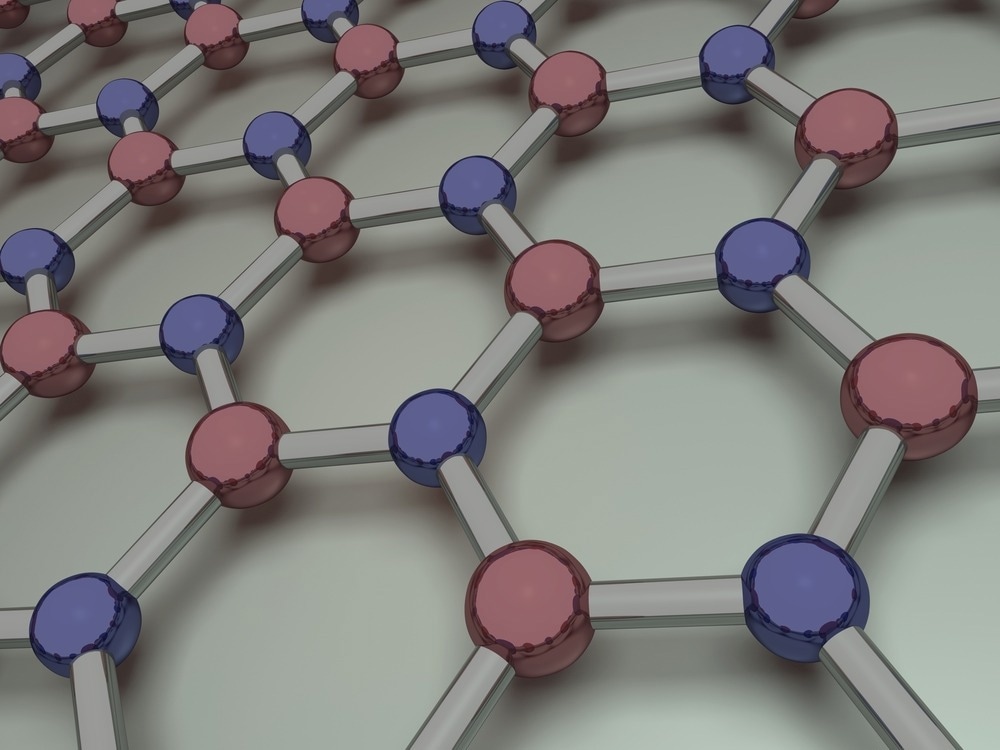Since the discovery of graphene in 2004, various 2D materials with diverse chemical compositions and interconnected physical properties have gained a lot of interest as prospective candidates for cutting-edge optical and electronic devices. Hexagonal boron nitride (hBN) is one of these materials as it has high stability and mechanical strength, with a wide range of potential applications.

Image Credit: ogwen/Shutterstock.com
Structural Arrangements in 2D hBN
hBN is a structural counterpart of graphite with an equal number of boron (B) and nitrogen (N) atoms alternately placed in a two-dimensional layer held together by weak van der Waals forces and alternating B and N atoms interconnected by strong covalent bonds.
The length of the B-N bond is 1.44 A°, which is extremely close to the length of the C-C bond in graphene, which is 1.42 A°. Because of their close lattice constant and structural properties to graphene, hBN nanosheets with a white appearance are frequently referred to as "white graphene."
Properties and Applications of 2D hBN
The bandgap of hBN is 5.9 eV, making it an excellent insulator. The band gap can be modulated successfully by employing an external electric field or by varying the distance between hBN layers.
In the visible range, 2D hBN displays no optical absorption spectrum (390-700 nm), but a significant absorption peak is found in the deep UV range, which is 200-220 nm.
2D hBN exhibits distinct advantages over bulk hBN, such as high thermal conductivity, exceptional strength, electrical insulation, low friction coefficient and high elastic modulus, offering a wide variety of applications.
2D hBN in Electronics
One of the most appealing applications of 2D hBN is the van der Waals heterostructure, created by stacking distinct 2D layers on top of each other. The construction of graphene devices on hBN substrates revealed that the heterostructure had nearly superior mobility and carrier inhomogeneities almost better than the devices on SiO2.
In addition, researchers reported the layers of B-C-N (BCN) structures exhibit band gaps and show electronic characteristics that are somewhere between hBN and pure graphene. It consists of domains of carbon phases and boron nitride with composition from boron nitride to graphene. This would facilitate the production of bandgap-engineered materials with characteristics different from hBN and graphene for optoelectronics applications.
Because of its extremely large band gap and UV luminescence feature, 2D hBN may be a viable material for utilization in UV detectors, photoemission and ultraviolet lasing.
The Use of 2D hBN as a Protective Barrier
2D hBN is a viable barrier to safeguard metals from corrosion and oxidation due to its great impermeability and non-reactivity to most chemicals. More specifically, because hBN is electrically insulating, it does not produce galvanic corrosion. For example, researchers found improved corrosion resistance of stainless steel after coating with hBN/polyvinyl alcohol in a simulated marine environment.
Furthermore, 2D hBN filled composites are expected to demonstrate a good shielding effect against radiations from space, indicating a prospective spaceship application
2D hBN in Thermal Applications
The low density, high strength, and large elastic modulus of 2D hBN facilitate the enhancement of the mechanical properties of polymer composites. At room temperature, 2D hBN has a thermal conductivity of up to 400 W/mK and is a potential contender for thermal applications.
For example, using merely 0.3 wt percent BNNS increased the strength and elastic modulus of Polymethyl methacrylate (PMMA) by 11% and 22%, respectively.
2D hBN in Batteries
Traditional polymer-based separators, which operate as physical barriers to prohibit electrical connections between electrodes, typically face safety difficulties when Li-ion batteries overheat. Researchers investigated an electrolyte composition based on ionic liquid and hBN that enabled the operation of Li-ion batteries with high efficiency over a wide range of temperatures up to 150 °C. Overall, the presence of hBN in the electrolyte increases oxidation resistance.
Furthermore, the so-called "shuttling of polysulfides" continues to impede the commercialization of lithium-sulfur (Li-S) batteries. In this regard, hBN is a beneficial material for minimizing polysulfide shuttling by chemically and electrically isolating the electrodes and enabling more stability.
A composite polymer film containing hBN provides significantly improved safety by enabling an ion-conducting channel and maintaining electrode partition.
2D hBN in Biomedical Applications
Because of its biocompatibility, hBN is used in a variety of exciting applications, such as drug delivery and an additive in tissue scaffolds to improve the thermal and mechanical properties of biocomposites.
hBN and hydroxyapatite poly (lactic-co-glycolic acid) composite scaffold was found to improve bone regeneration function to repair the fracture in parietal bones in rats. In addition to drug delivery and tissue scaffolding, hBN nanoparticles have been explored for antibacterial applications.
Commercial Applications of hBN
Because of its commercial viability, hBN has been widely used in a variety of industries. For example, hBN fillers for optimizing the thermal conductivity of polymers are one of the most common applications of hBN.
hBN is widely used for electrical insulation in consumer electronics such as Li-ion batteries, supercapacitors and other high-performance components to improve heat dissipation.
In the cosmetics industry, hBN is also in high demand. It is also used by nearly all major cosmetic product manufacturers, including make-up and skincare products.
References and Further Reading
Suhail, A., & Lahiri, I. (2020). Two‐Dimensional Hexagonal Boron Nitride and Borophenes. Layered 2D Advanced Materials and Their Allied Applications, 303-336. https://doi.org/10.1002/9781119655190.ch13
Roy, S. et al. (2021). Structure, Properties and Applications of Two‐Dimensional Hexagonal Boron Nitride. Advanced Materials, 33(44), 2101589. https://doi.org/10.1002/adma.202101589
Disclaimer: The views expressed here are those of the author expressed in their private capacity and do not necessarily represent the views of AZoM.com Limited T/A AZoNetwork the owner and operator of this website. This disclaimer forms part of the Terms and conditions of use of this website.